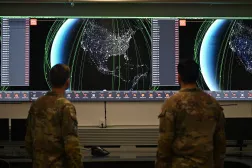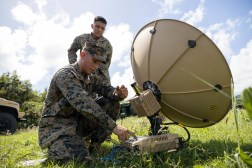Space Force getting cloud-based, classified environment for industry collaborations

A new prototype will soon allow the Space Force’s acquisition arm to work remotely on classified projects — with the goal to eventually create a shared network to facilitate collaboration with partners in industry and academia.
Known as Project Enigma, the digital environment aims to allow Space Systems Command (SSC) to collaborate with different stakeholders in a multi-enclave, cloud-based shared network. The service awarded GDIT an $18 million other transaction authority agreement in 2023 to develop the prototype digital infrastructure, and the company recently received an extension contract to add more capabilities to the platform, according to Travis Dawson, GDIT’s senior director for Project Enigma.
“This resulting digital services ecosystem will further drive resilient, secure information-sharing to anyone, anywhere, at any time,” Dawson said in an interview with DefenseScoop.
GDIT hosted around 200 government stakeholders for a demonstration of Project Enigma earlier this month at Los Angeles Air Force Base, where the company showcased some of the digital environment’s capabilities, including digital engineering tools, a software factory with DevSecOps pipelines, an IT service management desk and more.
“Working in a government setting and having the ability to sit at one device and do classified and unclassified work on the same device is monumental,” Dawson said. “Rather than having to leave your device and go to a secure facility, login with some classified credentials, etc., you can do that from one device.”
During the event, the company also demonstrated an initial operating capability of Project Enigma’s Commercial Solutions for Classified (CSFC) offering. Approved by the National Security Agency, CSFC allows users to work on classified networks either in-office on a desktop version known as a “trusted thin client” or remotely on a laptop, Dawson said.
“We’re rolling out both of those … right now, putting the trusted clients on the desk within Space Systems Command in L.A.,” he said. “Those provide the ability to securely communicate in … multiple independent levels of security simultaneously from a single device, and it ultimately could be from a remote device.”
The company is currently focused on enabling work in secret-level classified environments. There is some appetite within the U.S. government to add top secret and special access programs (SAP), but the company has yet to begin work on those, Dawson said.
Moving forward on its extended contract, GDIT is currently working on expanding access to Project Enigma beyond those within SSC and incorporating connections with industry partners, he noted.
GDIT also plans to add more mission partners and more commercial cloud service providers to the platform, creating a classified multi-cloud environment for collaboration, he said. While Dawson couldn’t name which cloud service providers would be integrated, he noted that they are companies approved by the Defense Department’s Joint Warfighting Cloud Capability contract vehicle. Microsoft, Oracle, Amazon Web Services and Google compete for task orders under the JWCC program.
The addition of commercial cloud is part of a larger GDIT effort known as digital accelerators, Dawson said. The company offers a portfolio of tailored solutions from the commercial sector — from artificial intelligence to cybersecurity — that can be brought into different platforms.
“These are integrated commercial technologies. They have been cyber hardened, and they’re customizable,” Dawson explained. “The customers can go ahead and customize them to their needs and their requirements, and they don’t have to be locked into any type of technology.”






